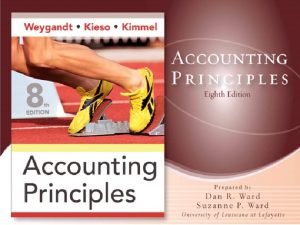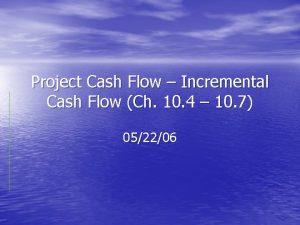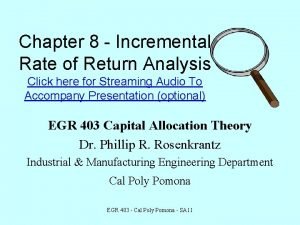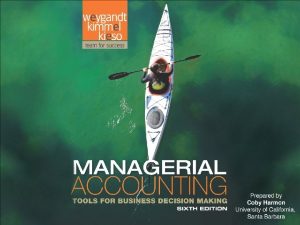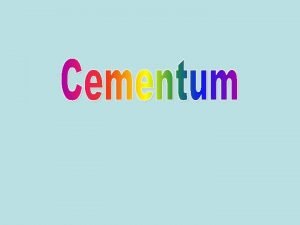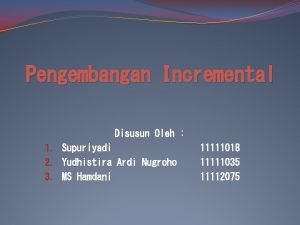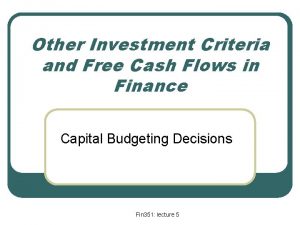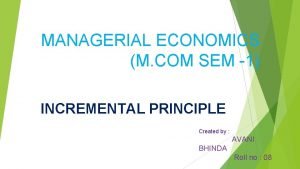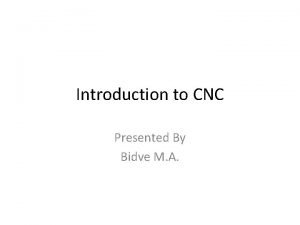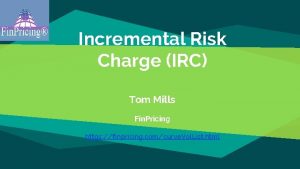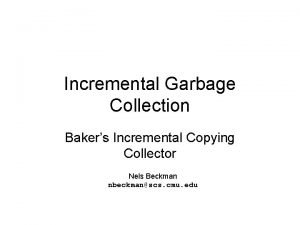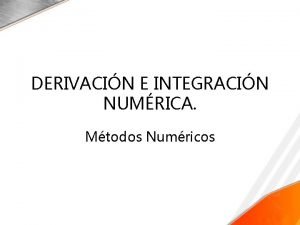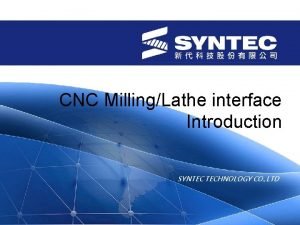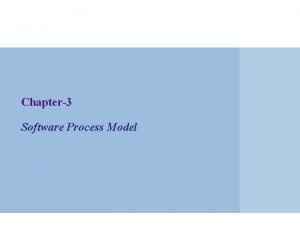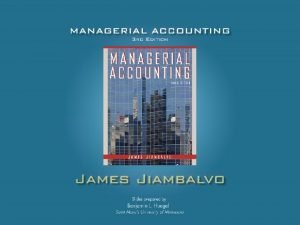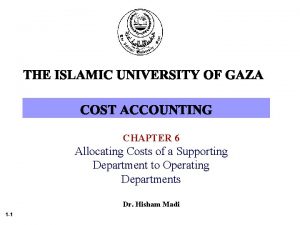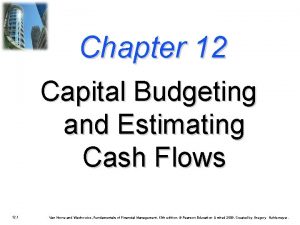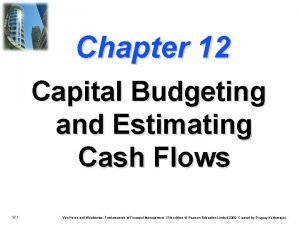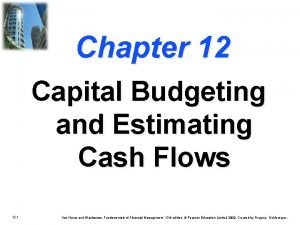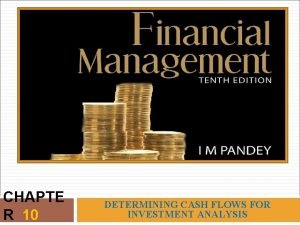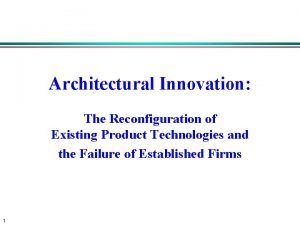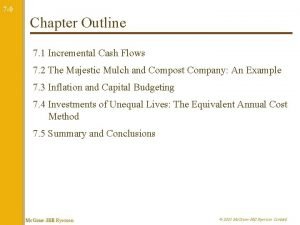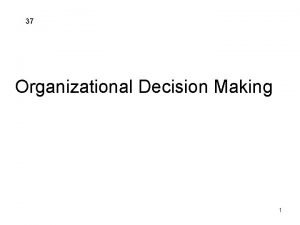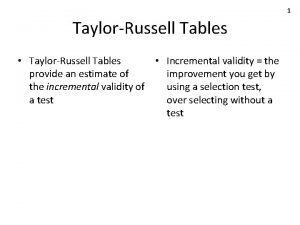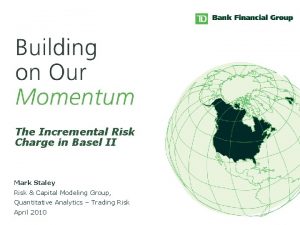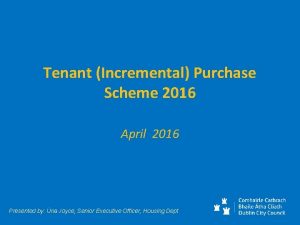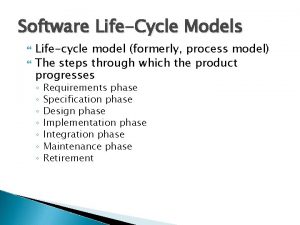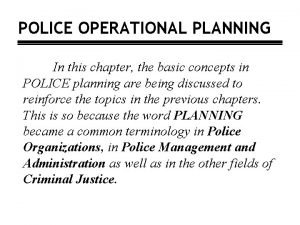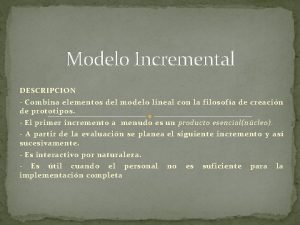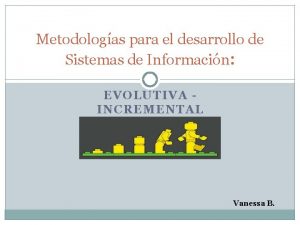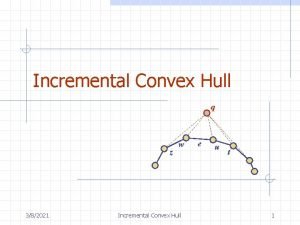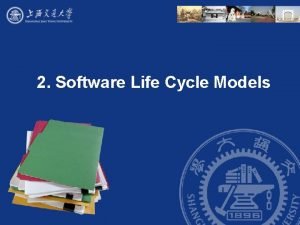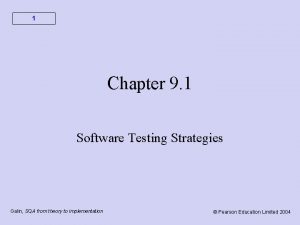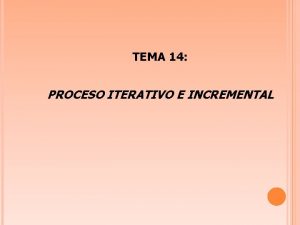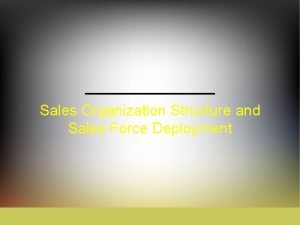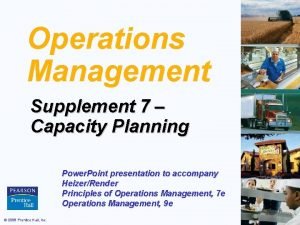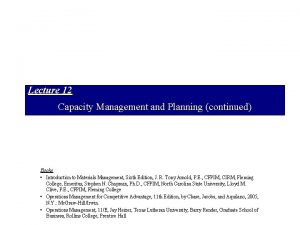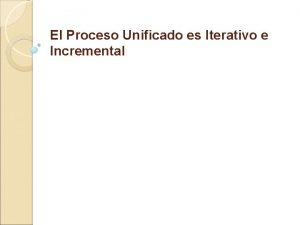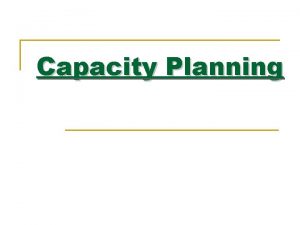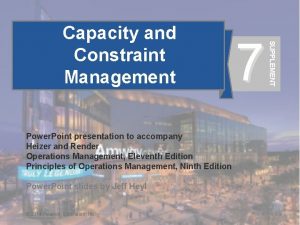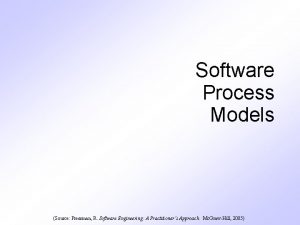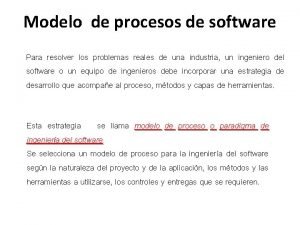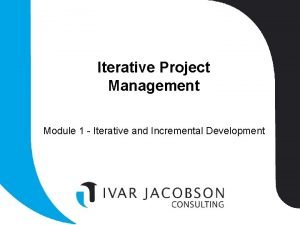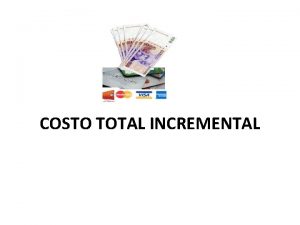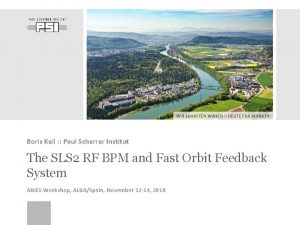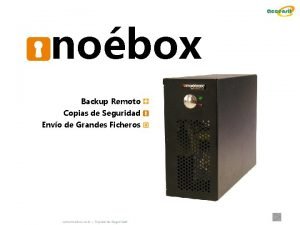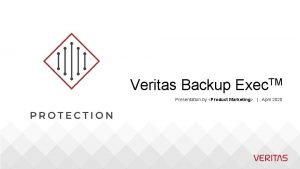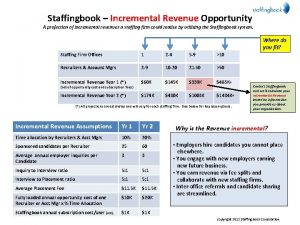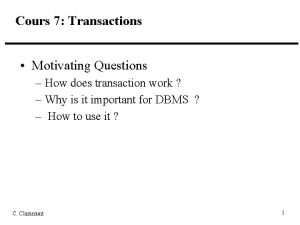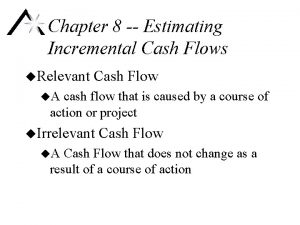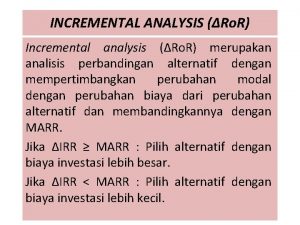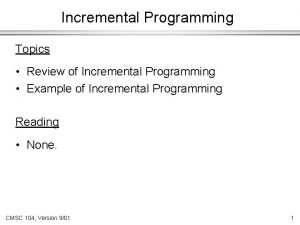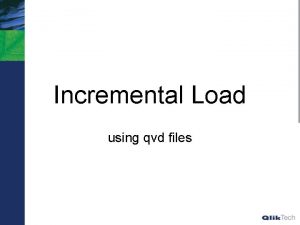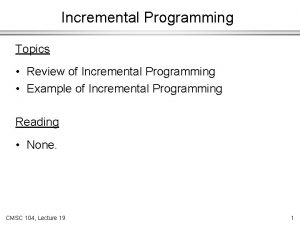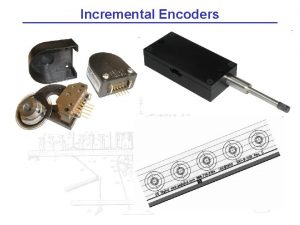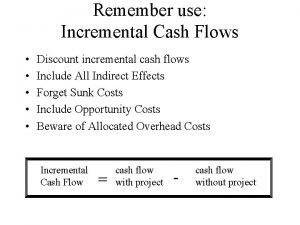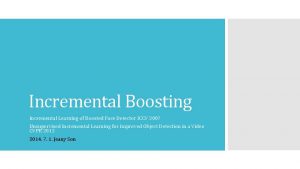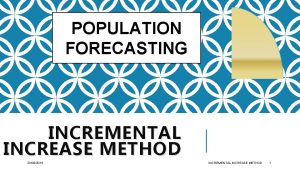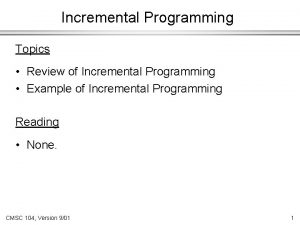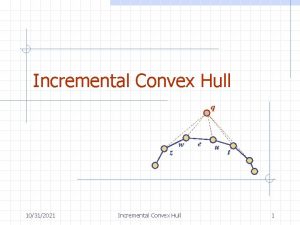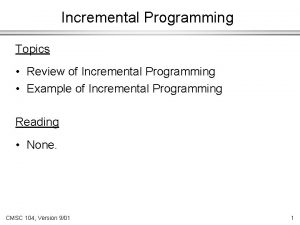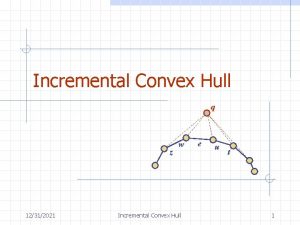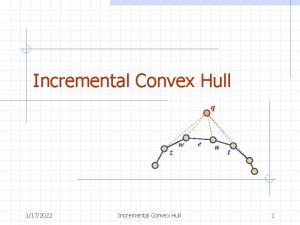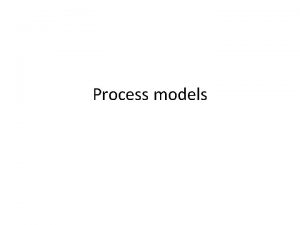Chapter 23 1 CHAPTER 23 INCREMENTAL ANALYSIS AND







































































- Slides: 71

Chapter 23 -1

CHAPTER 23 INCREMENTAL ANALYSIS AND CAPITAL BUDGETING Accounting, Fourth Edition Chapter 23 -2

Chapter Preview Chapter 23 -3

Study Objectives Chapter 23 -4 1. Identify the steps in management’s decisionmaking process. 2. Describe the concept of incremental analysis. 3. Identify the relevant costs in accepting an order at a special price. 4. Identify the relevant costs in a make-or-buy decision.

Study Objectives Chapter 23 -5 5. Give the decision rule for whether to sell or process materials further. 6. Identify the relevant costs to be considered in retaining or replacing equipment. 7. Explain the relevant factors in whether to eliminate an unprofitable segment.

Study Objectives 8. Determine which products to make and sell when resources are limited. 9. Contrast annual rate of return and cash payback in capital budgeting. 10. Distinguish between the net present value and internal rate of return methods. Chapter 23 -6

Preview of Chapter An important purpose of management accounting is to provide managers with relevant information for decision making. All companies must make product decisions – to cut prices to increase market share, to produce a higher priced product, to change their product mix, etc. Management frequently uses a decision-making process called incremental analysis. Chapter 23 -7

Management’s Decision-Making Process Decision-making is an important management function that does not always follow a set pattern. Steps in management’s decision-making process: Illustration 23 -1 Accounting helps management in making decisions by evaluating possible courses of action (step 2) and reviewing results (step 4). Chapter 23 -8 SO 1: Identify the steps in management’s decision-making process.

Management’s Decision-Making Process Both financial and nonfinancial information are considered in decision-making. Decisions vary in scope, urgency and importance. Financial information includes revenues and costs as well as their effect on profitability. Nonfinancial information relates to factors such as: the effect of the decision on employee turnover, the environment, or overall company image. Chapter 23 -9 SO 1: Identify the steps in management’s decision-making process.

Incremental Analysis Approach Decisions involve a choice among alternative courses of action. Financial data relevant to a decision are the data that vary in the future among alternatives. Both costs and revenues may vary, or Only costs may vary. Chapter 23 -10 SO 2: Describe the concept of incremental analysis.

Incremental Analysis Process used to identify the financial data that change under alternative courses of action. Identifies the probable effects of decisions on future earnings. Involves estimates and uncertainty. Incremental analysis is also called differential analysis because it focuses on differences. Chapter 23 -11 SO 2: Describe the concept of incremental analysis.

Incremental Analysis l GATHERING DATA MAY INVOLVE: l l Chapter 23 -12 MARKET ANALYSTS ENGINEERS ACCOUNTANTS NEED TO PRODUCE THE MOST RELIABLE INFORMATION AVAILABLE AT THE TIME THE DECISION MUST BE MADE. SO 2: Describe the concept of incremental analysis.

How Incremental Analysis Works Illustration 23 -2 Comparing alternative B to A, the incremental revenue will be $15, 000 less under alternative B than under alternative A. However, a $20, 000 incremental cost saving will be realized with alternative B. Thus, alternative B will produce $5, 000 more net income than A. Chapter 23 -13 SO 2: Describe the concept of incremental analysis.

Let’s Review Incremental analysis is the process of identifying the financial data that: a. Do not change under alternative courses of action b. Change under alternative courses of action. c. Are mixed under alternative courses of action. d. No correct answer is given. Chapter 23 -14 SO 2: Describe the concept of incremental analysis.

Types of Incremental Analysis Accept an order at a special price. Make or buy components or finished products. Sell products or process further. Retain or replace equipment. Eliminate an unprofitable business segment. Allocate limited resources. Chapter 23 -15 SO 2: Describe the concept of incremental analysis.

Accept an Order at a Special Price Obtain additional business by making price concessions to a specific customer. Assumes sales of the product in other markets would not be affected by this special order. Assumes company is not operating at full capacity. Chapter 23 -16 SO 3: Identify the relevant costs in accepting an order at a special price.

Accept an Order at a Special Price Mexico Co. offers to buy a special order of 2, 000 blenders at $11 per unit from Sunbelt. No effect on normal sales; sufficient plant capacity. Operating at 80 percent capacity = 100, 000 units. Current fixed manufacturing costs = $400, 000 or $4 per unit. Variable manufacturing cost = $8 per unit. Normal selling price = $20 per unit. Based strictly on total cost of $12 per unit ($8 + $4), reject offer as cost exceeds selling price of $11. Within existing capacity, thus no change in fixed costs, so they are not relevant for this decision. Chapter 23 -17 SO 3: Identify the relevant costs in accepting an order at a special price.

Accept an Order at a Special Price Offer 2, 000 units @ $11 per unit/ Normal sales Price $ 20 unit Fixed costs do not change. Variable manufacturing cost = $8 per unit. Total variable costs change – thus they are relevant. Illustration 23 -3 Revenue increases $22, 000; variable costs increase $16, 000. Income increases by $6, 000. Accept the Special Order. Chapter 23 -18 SO 3: Identify the relevant costs in accepting an order at a special price.

Let’s Review It costs a company $14 of variable costs and $6 of fixed costs to produce product Z 200 that sells for $30. A foreign buyer offers to purchase 3, 000 units at $18 each. If the special offer is accepted and produced with unused capacity, net income will: a. decrease $6, 000 b. increase $6, 000. c. increase $12, 000. d. increase $9, 000. Chapter 23 -19 $18 - $14= $4 $4 × 3, 000 units = $12, 000 SO 3: Identify the relevant costs in accepting an order at a special price.

Make or Buy Management must decide whether to make or buy components. The decision to buy parts or services rather than making them is called outsourcing. Example: Costs to produce 25, 000 switches. Illustration 23 -4 Chapter 23 -20 SO 4: Identify the relevant costs in a make-or-buy decision.

Make or Buy – Illustration 23 -4 Switches can be purchased for $8 per switch (25, 000 × $8 = $200, 000). At first look, the switches should be purchased; thus saving $1 per unit. Buying the switches eliminates all variable costs, but only $10, 000 of fixed costs ($ 60, 000 10, 000) = $50, 000 of fixed cost will remain. Chapter 23 -21 SO 4: Identify the relevant costs in a make-or-buy decision.

Make or Buy – The relevant costs for incremental analysis are: Illustration 23 -5 Baron Company will incur $25, 000 additional cost if switches are purchased. Continue to make switches. Chapter 23 -22 SO 4: Identify the relevant costs in a make-or-buy decision.

Make or Buy Opportunity Costs Definition: The potential benefits that may be obtained from following an alternative course of action. Assume Baron Company can use the newly available productive capacity from buying the switches to generate additional income of $28, 000 by making another product. If Baron makes the switches, this income is lost. Chapter 23 -23 SO 4: Identify the relevant costs in a make-or-buy decision.

Make or Buy – Opportunity Cost Example This opportunity cost, the lost income, is added to the “Make” column as an additional “cost” for comparative purposes. Illustration 23 -6 It is now advantageous to buy the switches. Baron Company will be $3, 000 better off. Chapter 23 -24 SO 4: Identify the relevant costs in a make-or-buy decision.

Let’s Review In a make-or-buy decision, relevant costs are: a. Manufacturing costs that will be saved b. The purchase price of the units. c. Opportunity costs. d. All of the above. Chapter 23 -25 SO 4: Identify the relevant costs in a make-or-buy decision.

Sell or Process Further Many manufacturers have the option of selling a product now or continuing to process hoping to sell at a higher price. Decision Rule: Process further as long as the incremental revenue from such processing exceeds the incremental processing costs. Chapter 23 -26 SO 5: Give the decision rule for whether to sell or process materials further.

Sell or Process Further Single-Product Case Cost to manufacture one unfinished table: Illustration 23 -7 Selling price of unfinished unit is $50; unused capacity can be used to finish the tables to sell for $60. Relevant unit costs of finishing tables: Direct materials increase $2; Direct labor increases $4. Variable manufacturing overhead costs increase by $2. 40 (60 percent of direct labor increase). Fixed manufacturing costs will not increase. Chapter 23 -27 SO 5: Give the decision rule for whether to sell or process materials further.

Sell or Process Further Incremental revenues ($10) exceed incremental costs ($8. 40); Income increases $1. 60 per unit. Process further. Chapter 23 -28 SO 5: Give the decision rule for whether to sell or process materials further.

Let’s Review The decision rule in a sell-or-process-further decision is process further as long as the incremental revenue from processing exceeds: a. Incremental processing costs b. Variable processing costs. c. Fixed processing costs. d. No correct answer is given. Chapter 23 -29 SO 5: Give the decision rule for whether to sell or process materials further.

Retain or Replace Equipment Management must decide whether a company should continue to use an asset or replace it. Example: Assessment of replacement of a factory machine: Book value Cost Remaining useful life Scrap value Old Machine $40, 000 Four years -0 - New Machine $120, 000 Four years -0 - Variable costs: Decrease from $160, 000 to $125, 000 annually. Chapter 23 -30 SO 6: Identify the factors to consider in retaining or replacing equipment.

Retain or Replace Equipment - Example Illustration 23 -9 Replace the equipment - Lower variable manufacturing costs more than offset cost of new equipment. The book value of the old machine does not affect the decision – it is a sunk cost. However, any trade-in allowance or cash disposal value of the old asset is relevant. Chapter 23 -31 SO 6: Identify the factors to consider in retaining or replacing equipment.

Let’s Review In a decision to retain or replace equipment, the book value of the old equipment is a/an: a. Opportunity cost b. Sunk cost. c. Incremental cost. d. Marginal cost. Chapter 23 -32 SO 6: Identify the factors to consider in retaining or replacing equipment.

Eliminate an Unprofitable Segment Should the company eliminate an unprofitable segment? Key: Focus on relevant costs. Consider effect on related product lines. Fixed costs allocated to the unprofitable segment must be absorbed by the other segments. Net income may decrease when an unprofitable segment is eliminated. Decision Rule: Retain the segment unless fixed costs eliminated exceed the contribution margin lost. Chapter 23 -33 SO 7: Explain the relevant factors in deciding whether to eliminate an unprofitable segment.

Eliminate an Unprofitable Segment Martina Company manufactures three models of tennis racquets: Profitable lines: Pro and Master Unprofitable line: Champ Condensed income statement data: Illustration 23 -10 Should the Champ line be eliminated? Chapter 23 -34 SO 7: Explain the relevant factors in deciding whether to eliminate an unprofitable segment.

Eliminate an Unprofitable Segment If Champ is eliminated, allocate its $30, 000 share of fixed costs: 2/3 to Pro and 1/3 to Master. Revised income statement data: Illustration 23 -11 Total income has decreased by $10, 000 ($220, 000 $210, 000). Chapter 23 -35 SO 7: Explain the relevant factors in deciding whether to eliminate an unprofitable segment.

Eliminate an Unprofitable Segment Incremental analysis of Champ provides the same results: Decision: Do not eliminate Champ. Chapter 23 -36 Illustration 23 -12

Let’s Review If an unprofitable segment is eliminated: a. Net income will always increase b. Variable expenses of the eliminated segment will have to be absorbed by other segments. c. Fixed expenses allocated to the eliminated segment will have to be absorbed by other segments. d. Net income will always decrease. Chapter 23 -37 SO 23: Identify the relevant costs in deciding whether to eliminate an unprofitable segment.

Other Considerations in Decision Making Many decisions involving incremental analysis have important qualitative features that must be considered in addition to the quantitative factors. Example – cost of lost morale due to outsourcing or eliminating a plant. Incremental analysis is completely consistent with activity-based costing (ABC). ABC often results in better identification of relevant costs and, thus, better incremental analysis. Chapter 23 -38

Allocate Limited Resources are always limited Floor space for a retail firm Raw materials, direct labor hours, or machine capacity for a manufacturing firm Management must decide which products to make and sell to maximize net income Chapter 23 -39 SO 8: Determine which products to make and sell when resources are limited.

Allocate Limited Resources Example: Collins Company manufactures deluxe and standard pen and pencil sets Limiting resource: 3, 600 machine hours per month Illustration 23 -13 Deluxe set has higher contribution margin: $8 Standard set takes fewer machine hours per unit Chapter 23 -40 SO 8: Determine which products to make and sell when resources are limited.

Allocate Limited Resources Example: Must compute contribution margin per unit of limited resource Standard sets have higher contribution margin per unit of limited resources Illustration 23 -14 Decision: Shift sales mix to standard sets or increase machine capacity Chapter 23 -41 SO 8: Determine which products to make and sell when resources are limited.

Allocate Limited Resources Example: Alternative: Increase machine capacity from 3, 600 to 4, 200 machine hours Illustration 23 -15 To maximize net income, all the additional 600 hours should be used to produce standard sets Chapter 23 -42 SO 8: Determine which products to make and sell when resources are limited.

Capital Budgeting The process of making capital expenditure decisions in business is known as Capital Budgeting The amount of possible capital expenditures usually exceeds the funds available for such expenditures Capital budgeting involves choosing among various capital projects to find the one(s) that will Maximize a company’s return on investment Chapter 23 -43

Capital Budgeting Authorization Process Chapter 23 -44

Capital Budgeting Evaluation Process v v Chapter 23 -45 Most methods to evaluate capital budgeting decisions employ cash flow numbers rather than accrual revenues and expenses. For capital budgeting, estimated cash inflows and outflows are the preferred inputs. WHY? Ultimately the value of financial investments is determined by the value of the cash flows received or paid.

Evaluation Process Providing management with relevant data for capital budgeting decisions requires familiarity with quantitative techniques. The most common techniques are: Annual Rate of Return Cash Payback Discounted Cash Flow Chapter 23 -46

Evaluation Process These techniques will be illustrated using the following data for Tappan Company: Investment in new equipment: $130, 000 Useful life of new equipment: 10 years Zero salvage and straight-line depreciation The expected annual revenues and costs of the new product that will be produced from the investment are: Chapter 23 -47 Illustration 23 -16

Annual Rate of Return Formula The annual rate of return technique is based on accounting data. It indicates the profitability of a capital expenditure. The formula is: Illustration 23 -17 The annual rate of return is compared with its required minimum rate of return for investments of similar risk. This minimum return is based on the company’s cost of capital, which is the rate of return that management expects to pay on all borrowed and equity funds. Chapter 23 -48 SO 8 Describe the annual rate of return method.

Annual Rate of Return The average investment is derived from the following formula: Illustration 23 -18 For Tappan Company the average investment is: [($130, 00 + $0) ÷ 2] = $65, 000 Chapter 23 -49 SO 9: Contrast annual rate of return and cash payback in capital budgeting.

Annual Rate of Return The expected rate of return for Tappan Company’s investment in new equipment is: $13, 000 ÷ $65, 000 = 20% The decision rule is: A project is acceptable if its rate of return is greater than management’s minimum rate of return. When choosing among several acceptable projects, the project with the higher rate of return is generally more attractive. Chapter 23 -50 SO 9: Contrast annual rate of return and cash payback in capital budgeting.

Annual Rate of Return Principal advantages of the annual rate of return technique: Simplicity of calculations Management’s familiarity with accounting terms used in the calculation Major limitation of the technique: It does not consider the time value of money As noted in Appendix D, recognition of the time value of money can make a significant difference between the present and future values of an investment. Chapter 23 -51 SO 9: Contrast annual rate of return and cash payback in capital budgeting.

Cash Payback Identifies the time period required to recover the cost of the investment Uses the net annual cash flow produced from the investment Net annual cash flow can be approximated by taking net income and adding back depreciation The formula for computing the cash payback period is: Illustration 23 -19 Chapter 23 -52 SO 9: Contrast annual rate of return and cash payback in capital budgeting.

Cash Payback Example: Tappan Company has net annual cash inflows of $26, 000 ( Net Income $13, 000 + Depreciation $13, 000) The cash payback period is: $130, 000 ÷ $26, 000 = 5 years Chapter 23 -53 SO 9: Contrast annual rate of return and cash payback in capital budgeting.

Cash Payback Example: Chen Company has uneven net annual cash inflows Now the cash payback period is determined when the cumulative net cash flows equal the cost of the investment Chapter 23 -54 Illustration 23 -21 SO 9: Contrast annual rate of return and cash payback in capital budgeting.

REVIEW Review Question Which of the following is incorrect about the annual rate of return technique? a. The calculation is simple b. The accounting terms used are familiar to management. c. The timing of the cash inflows is not considered. d. The time value of money is considered. Chapter 23 -55 SO 9: Contrast annual rate of return and cash payback in capital budgeting.

Discounted Cash Flow Discounted cash flow techniques generally recognized as best approach to making capital budgeting decisions Techniques consider both: Estimated total cash inflows, and The time value of money Two methods generally used with the discounted cash flow techniques are Net Present Value Method Internal Rate of Return Method Chapter 23 -56 SO 10: Distinguish between the net present value and internal rate of return methods.

Net Present Value Method NPV method compares the present value of the cash inflows to the capital outlay required by the investment The difference between the two amounts is referred to as the net present value The interest rate used to discount the cash flow is the required minimum rate of return A proposal is acceptable when the NPV is zero or positive The higher the positive NPV, the more attractive the investment Chapter 23 -57 SO 10: Distinguish between the net present value and internal rate of return methods.

Net Present Value Method Net Present Value Decision Criteria Chapter 23 -58 Illustration 23 -22 SO 10: Distinguish between the net present value and internal rate of return methods.

Net Present Value Method Example: Equal Annual Cash Flows Annual cash flows of $26, 000 uniform over asset’s useful life Calculation of present value of annual cash flows (annuity) at 2 different discount rates: Chapter 23 -59 Illustration 23 -23 SO 10: Distinguish between the net present value and internal rate of return methods.

Net Present Value Method Example: Equal Annual Cash Flows - Continued Analysis of proposal using net present values Illustration 23 -24 NPV positive for both discount rates Accept proposed capital expenditure at either discount rate Chapter 23 -60 SO 10: Distinguish between the net present value and internal rate of return methods.

Net Present Value Method Example: Unequal Annual Cash Flows Different cash flows each year over asset’s useful life; calculation of PV of annual cash flows at 2 different discount rates: Illustration 23 -25 Chapter 23 -61 SO 10: Distinguish between the net present value and internal rate of return methods.

Net Present Value Method Example: Unequal Annual Cash Flows - Continued Analysis of proposal using net present values Illustration 23 -26 NPV positive for both discount rates Accept proposed capital expenditure at either discount rate Chapter 23 -62 SO 10: Distinguish between the net present value and internal rate of return methods.

Internal Rate of Return Method IRR method finds the interest yield of the potential investment IRR – rate that will cause the PV of the proposed capital expenditure to equal the PV of the expected annual cash inflows Two steps in method Chapter 23 -63 1. Compute the interval rate of return factor 2. Use the factor and the PV of an annuity of 1 table to find the IRR. SO 10: Distinguish between the net present value and internal rate of return methods.

Internal Rate of Return Method Example: Step 1: The formula for computing the IRR factor: Illustration 23 -27 IRR factor for Tappan Company, assuming equal annual cash inflows: $130, 000 ÷ $26, 000 = 5. 0 Chapter 23 -64 SO 10: Distinguish between the net present value and internal rate of return methods.

Internal Rate of Return Method Example - Continued Step 2: IRR is the discount factor closest to the IRR factor for the time period covered by the annual cash flows. Closest discount factor to 5. 0 is 5. 01877; thus IRR is approximately 15% Chapter 23 -65 SO 10: Distinguish between the net present value and internal rate of return methods.

Internal Rate of Return Method Compare IRR to management’s required minimum rate of return Decision Rule: Accept the project when the IRR is equal to or greater than the required rate of return. Assuming a minimum rate of return for Tappan of 10%, project is accepted since IRR of 15% is greater than the required rate. Chapter 23 -66 SO 10: Distinguish between the net present value and internal rate of return methods.

Internal Rate of Return Method Illustration 23 -28 Chapter 23 -67 SO 10: Distinguish between the net present value and internal rate of return methods.

Comparison of Discounted Cash Flow Methods Illustration 23 -29 Chapter 23 -68 SO 10: Distinguish between the net present value and internal rate of return methods.

REVIEW A positive net present value means that the: a. Project’s rate of return is less than the cutoff rate b. Project’s rate of return exceeds the required rate of return. c. Project’s rate of return equals the required rate of return. d. Project is unacceptable. Chapter 23 -69 SO 10: Distinguish between the net present value and internal rate of return methods.

Review Question A $60, 000 project has net cash inflows for 10 years of $9, 349. Compute the internal rate of return from this investment. 8%. b. 10%. c. 9%. d. 11. a. Chapter 23 -70 Capital Investment = 60, 000 Net Annual Cash Flows 9, 349 = 6. 4177 SO 7 Explain the internal rate of return method.

Copyright © 2011 John Wiley & Sons, Inc. All rights reserved. Reproduction or translation of this work beyond that permitted in Section 117 of the 1976 United States Copyright Act without the express written permission of the copyright owner is unlawful. Request for further information should be addressed to the Permissions Department, John Wiley & Sons, Inc. The purchaser may make back-up copies for his/her own use only and not for distribution or resale. The Publisher assumes no responsibility for errors, omissions, or damages, caused by the use of these programs or from the use of the information contained herein. Chapter 23 -71
 Incremental analysis example
Incremental analysis example Incremental cash flows
Incremental cash flows Incremental rate of return analysis
Incremental rate of return analysis Payback chapter 23
Payback chapter 23 Prepare an incremental analysis for the special order
Prepare an incremental analysis for the special order Prepare an incremental analysis for the special order
Prepare an incremental analysis for the special order Guidelines for ethical listening
Guidelines for ethical listening What is cementoid
What is cementoid Pengertian perkembangan incremental
Pengertian perkembangan incremental Incremental cash flow
Incremental cash flow Incremental principle example
Incremental principle example Line drawing algorithm
Line drawing algorithm Incremental decision making
Incremental decision making Incremental coordinates
Incremental coordinates Irc market risk
Irc market risk Incremental garbage collection
Incremental garbage collection Inovação radical e incremental
Inovação radical e incremental Cociente incremental
Cociente incremental Incremental coordinates
Incremental coordinates What is incremental process model
What is incremental process model What is incremental revenue formula
What is incremental revenue formula Product vs process layout
Product vs process layout Incremental revenue allocation method
Incremental revenue allocation method What is incremental plagiarism
What is incremental plagiarism Incremental cash flows
Incremental cash flows Incremental cash flow
Incremental cash flow Incremental cash flow
Incremental cash flow Working capital investment example
Working capital investment example Architectural innovation
Architectural innovation Iatcf
Iatcf Incremental decision making model
Incremental decision making model Taylor russell tables
Taylor russell tables Incremental risk charge
Incremental risk charge Incremental purchase scheme
Incremental purchase scheme Synchronize and stabilize model
Synchronize and stabilize model Primary doctrines in police planning
Primary doctrines in police planning Modelo incremental
Modelo incremental Metodologia evolutiva incremental
Metodologia evolutiva incremental Incremental sampling method
Incremental sampling method Convex hull
Convex hull What are reasons to avoid name-calling in public speaking?
What are reasons to avoid name-calling in public speaking? Incremental life cycle model
Incremental life cycle model Big bang software testing
Big bang software testing Iterative game design
Iterative game design Incremental e iterativo
Incremental e iterativo Incremental approach in strategic management
Incremental approach in strategic management Salesforce sales organization structure
Salesforce sales organization structure Capacity planning in operations management
Capacity planning in operations management Incremental inductance
Incremental inductance Bumpy incremental change
Bumpy incremental change Rough cut capacity planning example
Rough cut capacity planning example Qvd files
Qvd files Iterativa e incremental
Iterativa e incremental Incremental vs one-step expansion
Incremental vs one-step expansion Capacity and constraint management
Capacity and constraint management Prototyping model in software engineering with diagram
Prototyping model in software engineering with diagram Fases del modelo incremental
Fases del modelo incremental Iterative project planning
Iterative project planning Cycle de vie incrémental
Cycle de vie incrémental Costo incremental
Costo incremental Boris keil
Boris keil Incremental increase method
Incremental increase method Noeblox
Noeblox Incremental planning
Incremental planning Fugle innovation process model
Fugle innovation process model Incremental decrease
Incremental decrease Backup exec forever incremental
Backup exec forever incremental Incremental revenue opportunity
Incremental revenue opportunity Incremental life cycle
Incremental life cycle Disruptive and radical innovation
Disruptive and radical innovation Incremental updates
Incremental updates Urelevant eller irrelevant
Urelevant eller irrelevant
